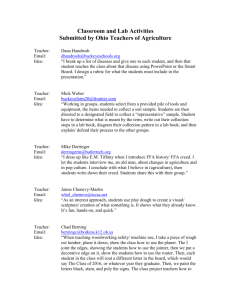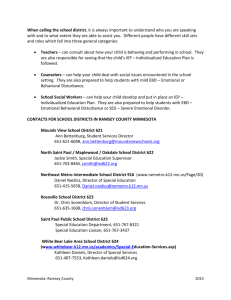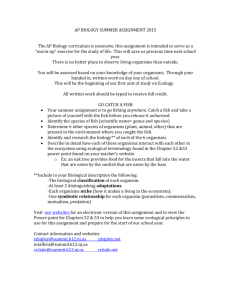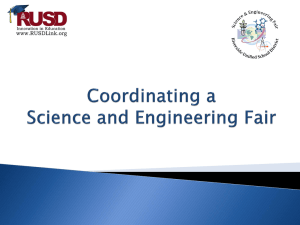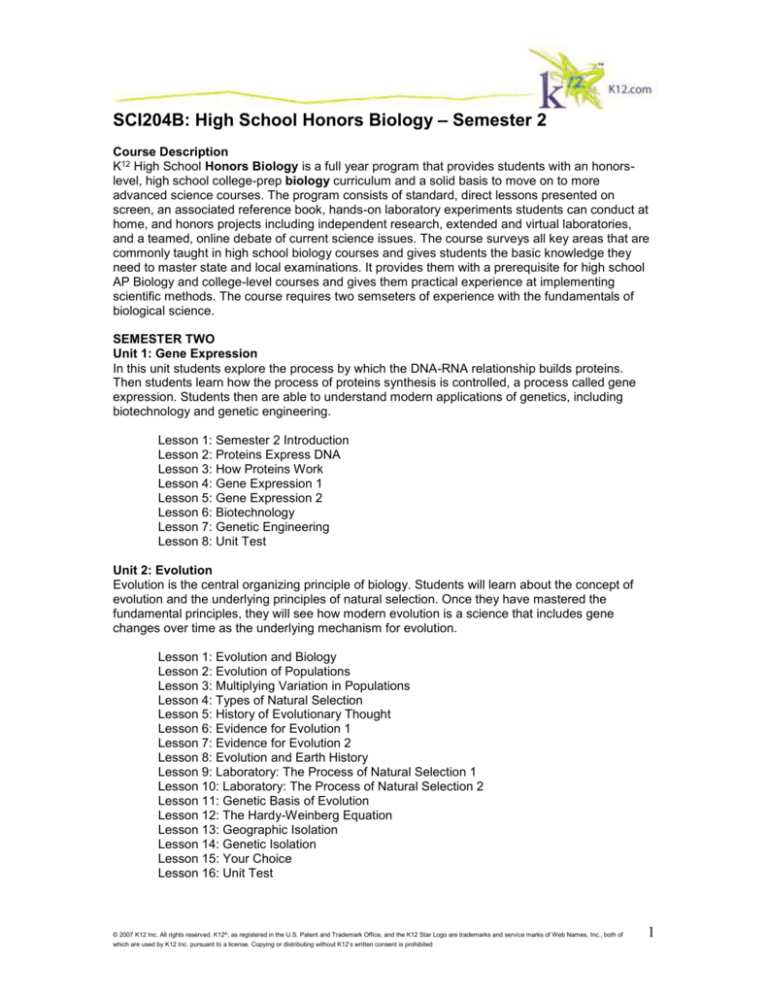
SCI204B: High School Honors Biology – Semester 2
Course Description
K12 High School Honors Biology is a full year program that provides students with an honorslevel, high school college-prep biology curriculum and a solid basis to move on to more
advanced science courses. The program consists of standard, direct lessons presented on
screen, an associated reference book, hands-on laboratory experiments students can conduct at
home, and honors projects including independent research, extended and virtual laboratories,
and a teamed, online debate of current science issues. The course surveys all key areas that are
commonly taught in high school biology courses and gives students the basic knowledge they
need to master state and local examinations. It provides them with a prerequisite for high school
AP Biology and college-level courses and gives them practical experience at implementing
scientific methods. The course requires two semseters of experience with the fundamentals of
biological science.
SEMESTER TWO
Unit 1: Gene Expression
In this unit students explore the process by which the DNA-RNA relationship builds proteins.
Then students learn how the process of proteins synthesis is controlled, a process called gene
expression. Students then are able to understand modern applications of genetics, including
biotechnology and genetic engineering.
Lesson 1: Semester 2 Introduction
Lesson 2: Proteins Express DNA
Lesson 3: How Proteins Work
Lesson 4: Gene Expression 1
Lesson 5: Gene Expression 2
Lesson 6: Biotechnology
Lesson 7: Genetic Engineering
Lesson 8: Unit Test
Unit 2: Evolution
Evolution is the central organizing principle of biology. Students will learn about the concept of
evolution and the underlying principles of natural selection. Once they have mastered the
fundamental principles, they will see how modern evolution is a science that includes gene
changes over time as the underlying mechanism for evolution.
Lesson 1: Evolution and Biology
Lesson 2: Evolution of Populations
Lesson 3: Multiplying Variation in Populations
Lesson 4: Types of Natural Selection
Lesson 5: History of Evolutionary Thought
Lesson 6: Evidence for Evolution 1
Lesson 7: Evidence for Evolution 2
Lesson 8: Evolution and Earth History
Lesson 9: Laboratory: The Process of Natural Selection 1
Lesson 10: Laboratory: The Process of Natural Selection 2
Lesson 11: Genetic Basis of Evolution
Lesson 12: The Hardy-Weinberg Equation
Lesson 13: Geographic Isolation
Lesson 14: Genetic Isolation
Lesson 15: Your Choice
Lesson 16: Unit Test
© 2007 K12 Inc. All rights reserved. K12®, as registered in the U.S. Patent and Trademark Office, and the K12 Star Logo are trademarks and service marks of Web Names, Inc., both of
which are used by K12 Inc. pursuant to a license. Copying or distributing without K12’s written consent is prohibited
1
Unit 3: Survey of Living Things 1
Students will learn about the structure and function of living things by examining three
representative organisms: a flatworm, a fern, and a human. In doing so students will examine
processes such as digestion and respiration—comparing and contrasting how living things obtain
food, break down food, eliminate waste, and obtain and use oxygen.
Lesson 1: Classification and Taxonomy
Lesson 2: Modern Classification
Lesson 3: Laboratory: Dichotomous Key
Lesson 4: Viruses and Prokaryotes
Lesson 5: Protists and Fungi
Lesson 6: Animals
Lesson 7: Plants
Lesson 8: Three Representative Organisms
Lesson 9: Your Choice
Lesson 10: Getting Energy
Lesson 11: Digestion
Lesson 12: Digestion in Humans
Lesson 13: Laboratory: Human Digestion Actions 1
Lesson 14: Waste Removal
Lesson 15: Laboratory: Human Digestion Actions 2
Lesson 16: Waste Removal in Humans
Lesson 17: Obtaining Oxygen
Lesson 18: Oxygen and the Human Body
Lesson 19: Your Choice
Lesson 20: Unit Test
Unit 4: Survey of Living Things 2
Students continue their examination of living things, focusing on three representative organisms.
They will explore the nervous and muscular systems and see how these systems aid in
responding to the organism’s environment. Students then examine various aspects of
reproduction among living things and finish with a study of defense.
Lesson 1: How Organisms Monitor Their Environments
Lesson 2: Human Nervous System
Lesson 3: Feedback Mechanisms
Lesson 4: How Living Things Respond to Their Environments
Lesson 5: Muscular Systems
Lesson 6: How Muscles Contract
Lesson 7: Laboratory: Chicken Muscles 1
Lesson 8: Laboratory: Chicken Muscles 2
Lesson 9: Fern Reproduction
Lesson 10: Flatworm Reproduction
Lesson 11: Human Reproduction
Lesson 12: How Organisms Defend Themselves
Lesson 13: Human Immune Response 1
Lesson 14: Human Immune Response 2
Lesson 15: Plant Defenses
Lesson 16: Your Choice
Lesson 17: Unit Test
Unit 5: Ecology and the Environment
As students have moved through this curriculum, they have learned about living things, their
structure, and functions. In this unit they will confront organisms in relation to their environments.
© 2007 K12 Inc. All rights reserved. K12®, as registered in the U.S. Patent and Trademark Office, and the K12 Star Logo are trademarks and service marks of Web Names, Inc., both of
which are used by K12 Inc. pursuant to a license. Copying or distributing without K12’s written consent is prohibited
2
Students will study living things and the ecosystems in which they live, examining both the biotic
and abiotic components of the world in which organisms exist.
Lesson 1: Individuals and Populations
Lesson 2: Communities
Lesson 3: Ecosystems
Lesson 4: Ecosystem Stability
Lesson 5: Biomes
Lesson 6: Biodiversity
Lesson 7: Energy Flow in Ecosystems
Lesson 8: Food Chains and Food Webs
Lesson 9: Your Choice
Lesson 10: Mid-Unit Test
Lesson 11: Succession
Lesson 12: Laboratory: Patterns of Succession
Lesson 13: Changes in Ecosystems
Lesson 14: Water and Nitrogen Cycles
Lesson 15: Carbon and Oxygen Cycles
Lesson 16: Laboratory: Fixation in Root Nodules 1
Lesson 17: Laboratory: Fixation in Root Nodules 2
Lesson 18: Laboratory: The Effects of Acidity on Seed Germination 1
Lesson 19: Natural Resources
Lesson 20: Environmental Challenges
Lesson 21: Global Temperatures
Lesson 22: Pollution
Lesson 23: Laboratory: The Effects of Acidity on Seed Germination 2
Lesson 24: Your Choice
Lesson 25: Unit Test
Unit 6: Semester 2 Review and Test
Lesson 1: Semester 2 Review
Lesson 2: Your Choice
Lesson 3: Your Choice
Lesson 4: Semester 2 Test
Unit 7: Honors Project 1:
Virtual Lab: Antibiotic ResistanceAntibiotic resistance describes how the effects of antibiotics
on certain bacteria will weaken or become ineffective over time. Students will investigate
antibiotic resistance by conducting an experiment in the K12 Virtual Science Lab.
Lesson 1: Virtual Lab: Antibiotic Resistance
Unit 8: Honors Project 2: Issues in Science: Online Debate
Research and technology produce new information and capabilities, as well as great
responsibility. The scientific community wrestles with the question, “Just because we can, does
that mean we should?” Examining all sides of an issue can sometimes bring together everyone’s
opinions. Other times, people just have to agree to disagree. Different sides of an issue can be
examined with a debate. The Issues in Science Online Debate is an opportunity for students to
examine current scientific issues and express opposing viewpoints through structured debate.
Students will work in collaborative teams to develop and present a case online. Teamwork and
sharing ideas will be emphasized, and students are encouraged to meet online or in person.
Lesson 1: Debates: A Different Way to Argue
Lesson 2: Gathering Evidence
Lesson 3: Building a Case
© 2007 K12 Inc. All rights reserved. K12®, as registered in the U.S. Patent and Trademark Office, and the K12 Star Logo are trademarks and service marks of Web Names, Inc., both of
which are used by K12 Inc. pursuant to a license. Copying or distributing without K12’s written consent is prohibited
3
Lesson 4: Reasoning and Refutation
Lesson 5: Effective Debating Strategies
Lesson 6: Debate: Constructive Argument
Lesson 7: Debate: First Rebuttal
Lesson 8: Debate: Second Rebuttal
Lesson 9: Debate: Summary Argument
Lesson 10: Discuss: Issues in Science Online Debate
© 2007 K12 Inc. All rights reserved. K12®, as registered in the U.S. Patent and Trademark Office, and the K12 Star Logo are trademarks and service marks of Web Names, Inc., both of
which are used by K12 Inc. pursuant to a license. Copying or distributing without K12’s written consent is prohibited
4


